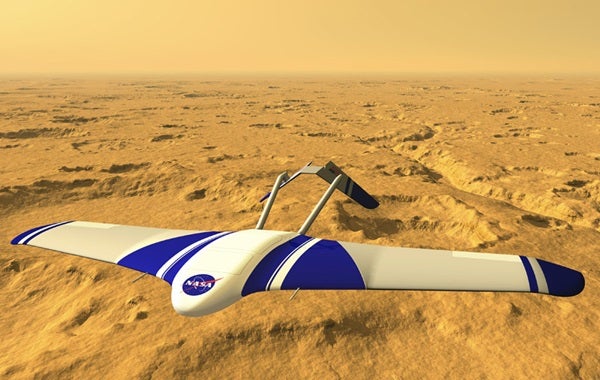An atmosphere-scooping bullet, a crater-gouging ball, and a robot airplane are among the ideas arriving today at NASA Headquarters in Washington. The proposals are part of a series of studies the agency is considering for its next “Scout” mission to Mars. The winner of this most recent set will be announced in January 2008.
Scout missions are fairly inexpensive, mid-size explorers with a narrow focus. Says Joel Levine, one Scout investigator: “It’s a good, competitive way to get the best science for Mars. It’s an exciting program.”
Levine heads one of this year’s 20 entries called the Aerial Regional-scale Environmental Survey (ARES). ARES proposes flying over the Red Planet in a 21-foot-wingspan plane. The plane, designed by Lockheed Martin and NASA’s Langley Research Center, would unfold its wings and start its solid-rocket engines about a mile above Mars’ surface. During a 2-hour flight, the winged explorer would examine magnetic fields in the most ancient parts of Mars’ crust and search for methane and other life-related gases. All this would happen while it sends video of aerial vistas to Earth.
A second proposal, called Sample Collection for Investigation of Mars (SCIM), would streak through Mars’ upper atmosphere, collecting 1,000 dust grains and about a quart of martian air for return to Earth. The same team that successfully brought back comet samples in the Stardust spacecraft would build SCIM.
Another entry is called THOR, for Tracing Habitability, Organics and Resources. The THOR mother ship would carry two copper spheres — one weighing 990 pounds and the other a whopping 2,640 — that would be deployed a week before the craft reaches Mars. The balls would fall to the planet’s surface at 12,000 mph (19,300 kilometers per hour), gouging out small craters. Scientists expect the largest crater to be 15 feet (4.5 meters) deep and 100 feet (30m) across. The mother ship, settled into orbit above, would study the new craters for several months, searching for fresh water-ice. It would also chart sites with subsurface water for future missions.
MAVEN, the Mars Atmosphere and Volatile Evolution, is a fourth submission. This Mars orbiter would study the dynamics of Mars’ upper atmosphere to determine how Mars originally lost its atmosphere. MAVEN would borrow heavily from designs of two other Lockheed Martin Mars orbiters, the Mars Global Surveyor and Mars Odyssey.
The most recent Scout mission chosen for Mars was the Phoenix polar lander. Phoenix is scheduled for launch in August 2007.










